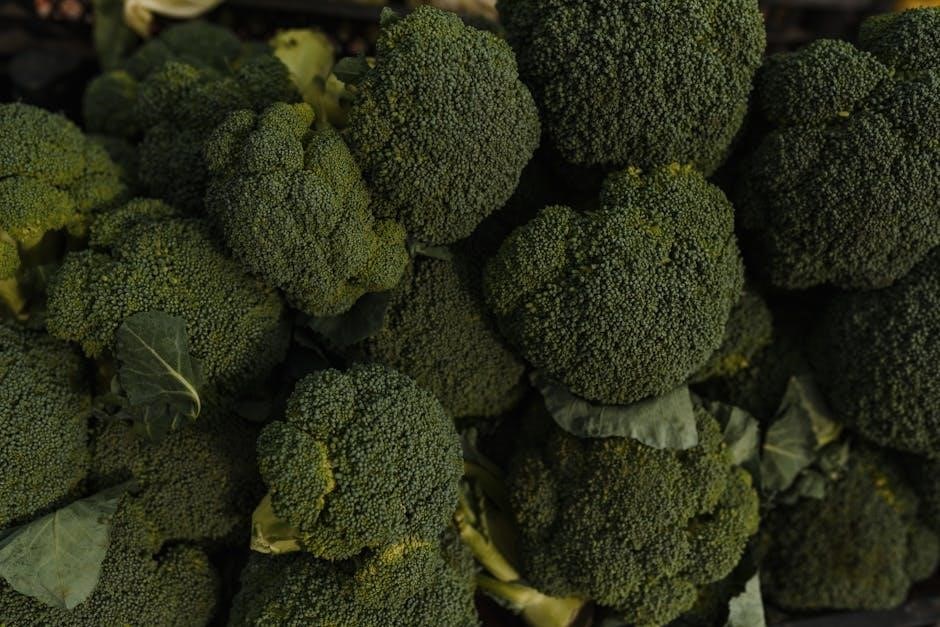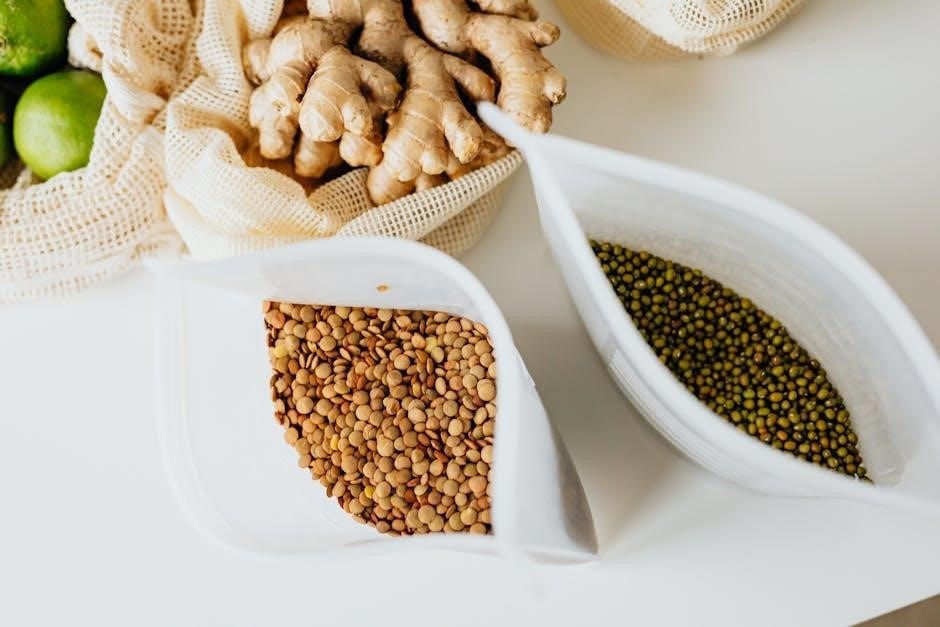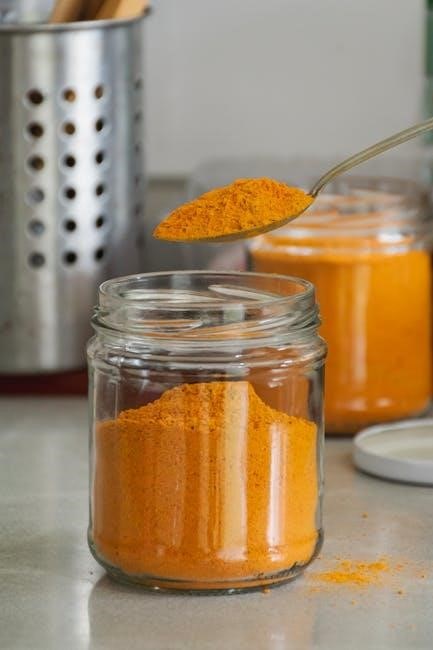Anti-Inflammatory Foods: A Comprehensive Guide

Embark on a journey towards better health with our comprehensive
guide to anti-inflammatory foods. This visual aid, often in PDF
format, highlights foods rich in essential fatty acids and
antioxidants, providing a clear path to reduce inflammation and
support overall well-being by choosing the right foods;
Understanding Inflammation
Inflammation, a natural response to injury or infection, becomes
problematic when it persists chronically. This ongoing inflammation
can stem from various sources, including stress, tissue damage, and,
crucially, dietary choices. Consuming foods that promote
inflammation or neglecting anti-inflammatory foods contributes to this
state. Recognizing this connection is the first step towards
adopting an anti-inflammatory lifestyle.
An anti-inflammatory food list PDF serves as a visual guide,
highlighting foods that combat inflammation. These lists emphasize
whole plant foods, rich in antioxidants that prevent or reduce
inflammation. Understanding that food choices directly impact
inflammatory responses empowers individuals to make informed
decisions. Chronic inflammation is linked to various diseases,
making dietary intervention a powerful tool.
The PDF resources often categorize foods based on their
inflammatory potential, offering a clear overview of what to include
and what to limit in your diet. By understanding the role of
specific nutrients and compounds in foods, individuals can actively
manage their inflammation levels and proactively support their
long-term health. This proactive approach, guided by visual aids
like the anti-inflammatory food list PDF, promotes a healthier and
more balanced lifestyle.
What is Inflammation?
Inflammation is the body’s natural defense mechanism, a complex
biological response to harmful stimuli like pathogens, damaged cells,
or irritants. It’s a vital process for healing and repair, but when
it becomes chronic, it can lead to various health issues. Acute
inflammation is short-term, characterized by redness, swelling, heat,
and pain, signaling the body’s effort to restore normalcy.
However, chronic inflammation, a prolonged and often silent
process, can damage tissues and organs over time. This type of
inflammation is often linked to lifestyle factors, particularly
diet. An anti-inflammatory food list PDF can be a valuable tool in
understanding which foods contribute to or combat this chronic
state. These resources typically highlight foods rich in
antioxidants, omega-3 fatty acids, and other compounds known for
their anti-inflammatory properties.
By understanding the difference between acute and chronic
inflammation and recognizing the role of diet, individuals can take
proactive steps to manage their health. The anti-inflammatory food
list PDF provides a visual guide to making informed food choices,
helping to reduce the risk of chronic diseases associated with
uncontrolled inflammation. Ultimately, understanding inflammation
is key to adopting a healthier lifestyle and promoting long-term
well-being.
Causes of Chronic Inflammation
Chronic inflammation, a persistent and often silent threat, stems
from various underlying causes. One of the primary drivers is
diet. Consuming processed foods, sugary drinks, and unhealthy fats
can trigger inflammatory responses in the body, leading to a chronic
state of inflammation. Conversely, a diet lacking in anti-inflammatory
foods can also contribute. This is where an anti-inflammatory food
list PDF becomes invaluable, offering a clear guide to incorporating
beneficial foods.
Beyond diet, chronic stress plays a significant role. Prolonged
stress can disrupt the body’s hormonal balance, leading to
inflammation. Similarly, injured tissue, if not properly healed, can
cause ongoing inflammation. Lifestyle factors such as lack of
exercise, smoking, and excessive alcohol consumption also exacerbate
the problem. Furthermore, certain autoimmune disorders and chronic
infections can trigger persistent inflammation.
To mitigate these causes, adopting a holistic approach is essential.
This includes incorporating anti-inflammatory foods highlighted in
PDF guides, managing stress through relaxation techniques, engaging
in regular physical activity, and addressing any underlying health
conditions. By understanding and addressing the root causes of
chronic inflammation, individuals can take proactive steps to improve
their overall health and well-being. The anti-inflammatory food list
PDF serves as a practical tool in this journey, empowering informed
food choices.

The Anti-Inflammatory Diet
The anti-inflammatory diet emphasizes whole, unprocessed foods,
reducing inflammation and the risk of chronic diseases. Utilize an
anti-inflammatory food list PDF to guide your choices, focusing on
fruits, vegetables, healthy fats, and lean proteins for optimal health.
Core Principles of an Anti-Inflammatory Diet
The cornerstone of an anti-inflammatory diet revolves around
prioritizing whole, unprocessed foods. This approach inherently
limits added sugars, processed items, and unhealthy fats that can
trigger inflammation. Embracing a plant-based foundation, rich in
fruits, vegetables, whole grains, nuts, and seeds, is paramount.
These foods are packed with antioxidants and phytonutrients, which
combat inflammation at a cellular level.
A crucial aspect is the inclusion of healthy fats, particularly
omega-3 fatty acids found in fatty fish like salmon, mackerel, and
sardines. These fats play a vital role in reducing inflammation and
supporting overall health. Furthermore, incorporating extra-virgin
olive oil, avocado oil, flaxseed oil, and walnut oil provides
additional anti-inflammatory benefits.
Conversely, limiting or avoiding pro-inflammatory foods is equally
important. This includes refined carbohydrates, sugary beverages,
processed meats, and excessive alcohol consumption. By adhering to
these core principles and utilizing resources like an
anti-inflammatory food list PDF, individuals can effectively manage
inflammation and promote long-term well-being. Remember that while
some people focus on weight loss, this diet is for inflammation.
Foods to Include in Your Anti-Inflammatory Diet
Building an anti-inflammatory diet involves incorporating a wide
array of nutrient-rich foods that actively combat inflammation.
Focus on filling your plate with a colorful assortment of fruits and
vegetables, aiming for a “rainbow” of choices to maximize your
intake of diverse phytonutrients. Berries, such as blueberries,
strawberries, and raspberries, are particularly potent sources of
antioxidants.

Healthy fats are another essential component. Prioritize sources
like fatty fish (salmon, tuna, mackerel, sardines), extra-virgin
olive oil, avocados, nuts, and seeds. These provide omega-3 fatty
acids and other beneficial compounds that help regulate the
inflammatory response. Incorporating whole grains like oats, quinoa,
and brown rice offers fiber and additional nutrients.
Lean protein sources, such as poultry and legumes, also play a role
in a balanced anti-inflammatory diet. Remember to consult an
anti-inflammatory food list PDF for a comprehensive visual guide to
help you make informed choices. By consistently including these
foods in your meals, you can create a dietary foundation that
supports your body’s natural ability to fight inflammation and
promote overall health and well-being.
Fruits and Vegetables
Fruits and vegetables stand as cornerstones of an anti-inflammatory
diet, offering a rich array of vitamins, minerals, and potent
antioxidants that combat inflammation at its source. Prioritize a
colorful variety, aiming for a “rainbow” on your plate to maximize
the intake of diverse phytonutrients. Berries, such as blueberries,
strawberries, raspberries, and cherries, are particularly
beneficial due to their high concentration of antioxidants.
Leafy green vegetables like spinach, kale, and collard greens are
packed with vitamins and minerals, while cruciferous vegetables
like broccoli, cauliflower, and Brussels sprouts offer unique
compounds that support detoxification and reduce inflammation.
Consider incorporating sweet potatoes, known for their
anti-inflammatory properties, into your meals.

Refer to an anti-inflammatory food list PDF for a visual guide that
categorizes fruits and vegetables based on their anti-inflammatory
potential. Remember, fresh is often best, but frozen options can
also be a convenient and nutritious choice. By consistently
including a generous serving of fruits and vegetables in your diet,
you can significantly reduce inflammation and promote overall
health and well-being.

Healthy Fats

Healthy fats are crucial components of an anti-inflammatory diet,
playing a vital role in reducing inflammation and supporting
overall health. Incorporating the right types of fats can
significantly contribute to managing inflammation levels within the
body. Among the most beneficial are omega-3 fatty acids, renowned
for their anti-inflammatory properties.
Extra virgin olive oil stands out as a top choice, packed with
antioxidants and healthy monounsaturated fats. Avocado oil provides
a similar profile, offering versatility in cooking and salad
dressings. Flaxseed oil, hempseed oil, and walnut oil are excellent
plant-based sources of omega-3 fatty acids.
An anti-inflammatory food list PDF can serve as a handy guide for
identifying healthy fats to include in your diet. Remember to
prioritize these beneficial fats over saturated and trans fats,
which can promote inflammation. By making conscious choices to
incorporate healthy fats into your daily meals, you can effectively
combat inflammation and foster a healthier, more balanced
lifestyle. Focus on incorporating these fats in moderation as part
of a well-rounded dietary approach.
Fatty Fish
Fatty fish are nutritional powerhouses, celebrated for their rich
content of omega-3 fatty acids, particularly EPA and DHA. These
essential fats play a pivotal role in reducing inflammation
throughout the body, making fatty fish a cornerstone of an

anti-inflammatory diet; Incorporating these fish into your regular
meals can significantly contribute to overall health and well-being.

Salmon is a top choice, known for its high omega-3 content and
delicious flavor. Sardines, often overlooked, are packed with
nutrients and offer a concentrated source of anti-inflammatory fats.
Mackerel provides a similar profile, delivering a potent dose of
omega-3s. Tuna, especially albacore, is another excellent option,
though it’s essential to consume it in moderation due to mercury
levels.
An anti-inflammatory food list PDF can be an invaluable resource for
identifying and selecting the best types of fatty fish to include in
your diet. Aim to consume fatty fish at least twice a week to reap
the full benefits of their anti-inflammatory properties. By making
this dietary adjustment, you can effectively combat inflammation and
support a healthier, more balanced lifestyle. Prioritize wild-caught
varieties whenever possible to ensure optimal nutrient content and
minimize exposure to contaminants.
Nuts and Seeds
Nuts and seeds are nutritional gems, offering a wealth of
anti-inflammatory benefits that can significantly contribute to
overall health. These plant-based powerhouses are packed with
healthy fats, fiber, and antioxidants, making them an excellent
addition to any anti-inflammatory diet. Including a variety of nuts
and seeds in your daily meals can help reduce inflammation and
support a balanced, healthy lifestyle.
Almonds are a popular choice, providing vitamin E and monounsaturated
fats. Walnuts stand out for their high omega-3 fatty acid content,
particularly ALA, which the body converts into EPA and DHA. Flaxseeds
are another great source of omega-3s and fiber. Chia seeds are also
rich in fiber and antioxidants, promoting gut health and reducing
inflammation.
An anti-inflammatory food list PDF can be a valuable tool for
identifying the best nuts and seeds to incorporate into your diet.
It’s important to consume nuts and seeds in moderation, as they are
calorie-dense. Opt for raw or lightly roasted varieties to avoid
added sugars and unhealthy oils. By making nuts and seeds a regular
part of your diet, you can effectively combat inflammation and
support your body’s natural healing processes. Enjoy them as a
snack, add them to salads, or sprinkle them on your morning oatmeal
for a nutritious boost.
Foods to Avoid or Limit
To effectively combat inflammation, it’s crucial not only to
incorporate anti-inflammatory foods but also to be mindful of foods
that can exacerbate inflammation. Certain dietary choices can
trigger or worsen inflammatory responses in the body, undermining
the benefits of an anti-inflammatory diet. Identifying and limiting
these foods is a key step in managing chronic inflammation and
promoting overall health. Consulting an anti-inflammatory food list
PDF can provide a clear guide on which foods to avoid or consume in
moderation.
Processed foods are often high in unhealthy fats, added sugars, and
artificial additives, all of which can contribute to inflammation.
Sugary drinks, such as sodas and sweetened juices, are also major
culprits, leading to rapid spikes in blood sugar and increased
inflammation. Refined carbohydrates, found in white bread, pastries,
and many processed snacks, can have a similar effect. Red and
processed meats, such as bacon, sausage, and deli meats, are linked
to higher levels of inflammation in the body.
Additionally, excessive alcohol consumption can promote inflammation
and impair liver function. Trans fats, often found in fried foods and
processed snacks, are particularly harmful and should be avoided
altogether. By minimizing your intake of these inflammatory foods,
you can create a more favorable environment for healing and reduce
the risk of chronic diseases associated with inflammation.

Anti-Inflammatory Food List PDF: A Visual Guide
In today’s fast-paced world, navigating the complexities of dietary
choices can be challenging. To simplify the process of adopting an
anti-inflammatory diet, we offer a visual guide in PDF format. This
resource serves as an accessible and user-friendly tool for
identifying foods that can help reduce inflammation and promote
overall well-being. The anti-inflammatory food list PDF provides a
quick reference to incorporate these beneficial foods into your
daily meals.
Our anti-inflammatory food list PDF is designed to be easily
understandable, with clear categories and visually appealing layouts.
It highlights key foods known for their anti-inflammatory properties,
such as fruits, vegetables, healthy fats, and lean proteins. Each
food item is accompanied by a brief description of its benefits and
how it contributes to reducing inflammation in the body. The PDF
format allows for convenient access on various devices, making it a
valuable resource at home, in the grocery store, or on the go.
By using this visual guide, you can effortlessly incorporate
anti-inflammatory foods into your diet and take proactive steps
towards a healthier, more vibrant life. Download our
anti-inflammatory food list PDF today and embark on a journey to
better health through informed dietary choices.

